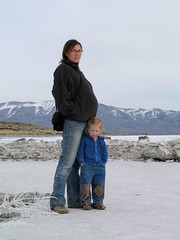Our petroglyph project is finished and I'm pretty happy with the results. Now I can tell you all about it. First we spent time looking at images from Parowan Gap. We talked about how many people believe that the pictures there represent seasons and important dates. Many of them are even thought to be calendars.I then had each student pick an important date that they'd like to represent in a petroglyph. Of course many of them chose holidays and birthdays. Then they worked through their petroglyph planner. The each had to draw four petroglyphs using only shapes, lines and dots, to represent their important date. For example, April 10th could be four long squiggly lines and ten polka dots. Or it could be four concentric circles with ten lines radiating out.
Next I passed out brown markers and had them each trace over their petroglyph designs, focusing on line quality. They should make some lines thick, some lines thin, and some could be a combination of both. The next time we met we actually started on the glyphs. I passed out six inch square pieces of sheet rock with the paper torn off one side (it was a lot of work to get them ready.) They each picked their favorite of the four designs they had made, then traced it onto the plaster side of the sheet rock tile.
The next time we met we actually started on the glyphs. I passed out six inch square pieces of sheet rock with the paper torn off one side (it was a lot of work to get them ready.) They each picked their favorite of the four designs they had made, then traced it onto the plaster side of the sheet rock tile.
Next we went outside on the grass. We got the tiles wet and carved the petroglyphs using large nails. The water cuts down on the dust and softens the plaster for carving. The kids had to rewet their tiles often in our dry climate. I also asked them to remember line quality and work on some thick and thin lines.The next time we met we painted our petroglyphs. We talked about the natural patina at Parowan gap and how the Native Americans scratched through the surface to reveal the sandstone color underneath. Our painting is kind of backwards from the way petroglyphs are actually made. We first painted the carved plaster with a sandstone color. The kids had to make sure they got the color all the way down into their carved lines. When that paint was mostly dry, then painted over the top with dark brown and black. They had to be careful this time to keep the dark paint OUT of the carved lines. I asked them to mottle the brown and black. They wanted it to look like someone had chipped it out of the mountain (although they should NEVER chip a real petroglyph out of a mountain.)
While the kids worked we got to talk about the people who made the real petroglyphs. I asked them to imagine how it must have been to carve away at real mountains, standing up. We talked about how important their carvings must have been to them and how much work and time it would take to make them. I hope that when these students visit the Gap in a week, they'll think about the people behind the petroglyphs.Plus, this project was a real hit. So many kids from other grades are asking me when they'll get to make their own petroglyphs. And many of the adults have asked me what kind of stone we used to carve. Most people can't guess what they're made from. Some teachers want to take them home and hang them in their living rooms. Hooray.
Wednesday, April 23, 2008
Petroglyphs Part Two
Posted by
Alisa
at
12:19 PM
![]()
Subscribe to:
Post Comments (Atom)


No comments:
Post a Comment